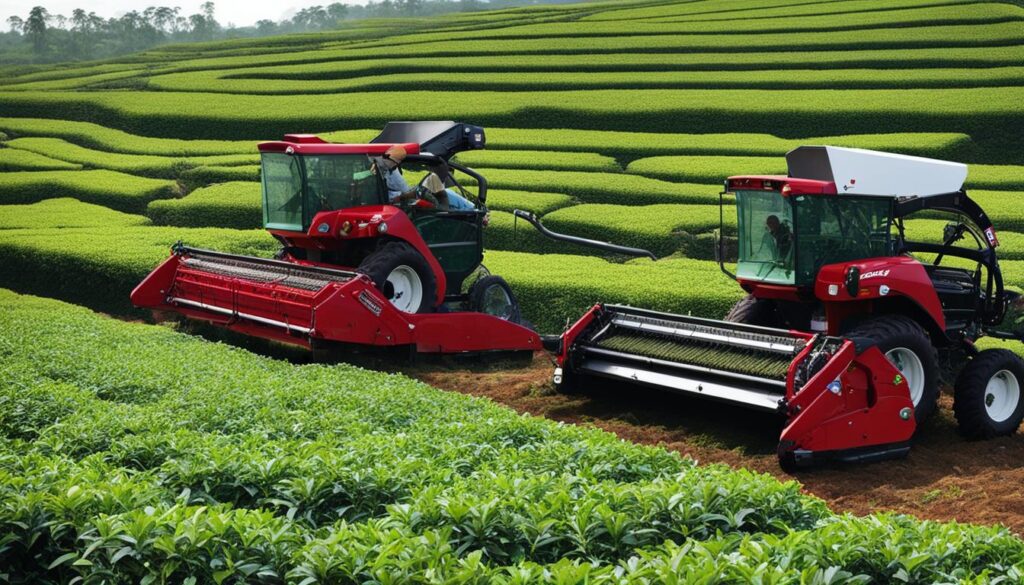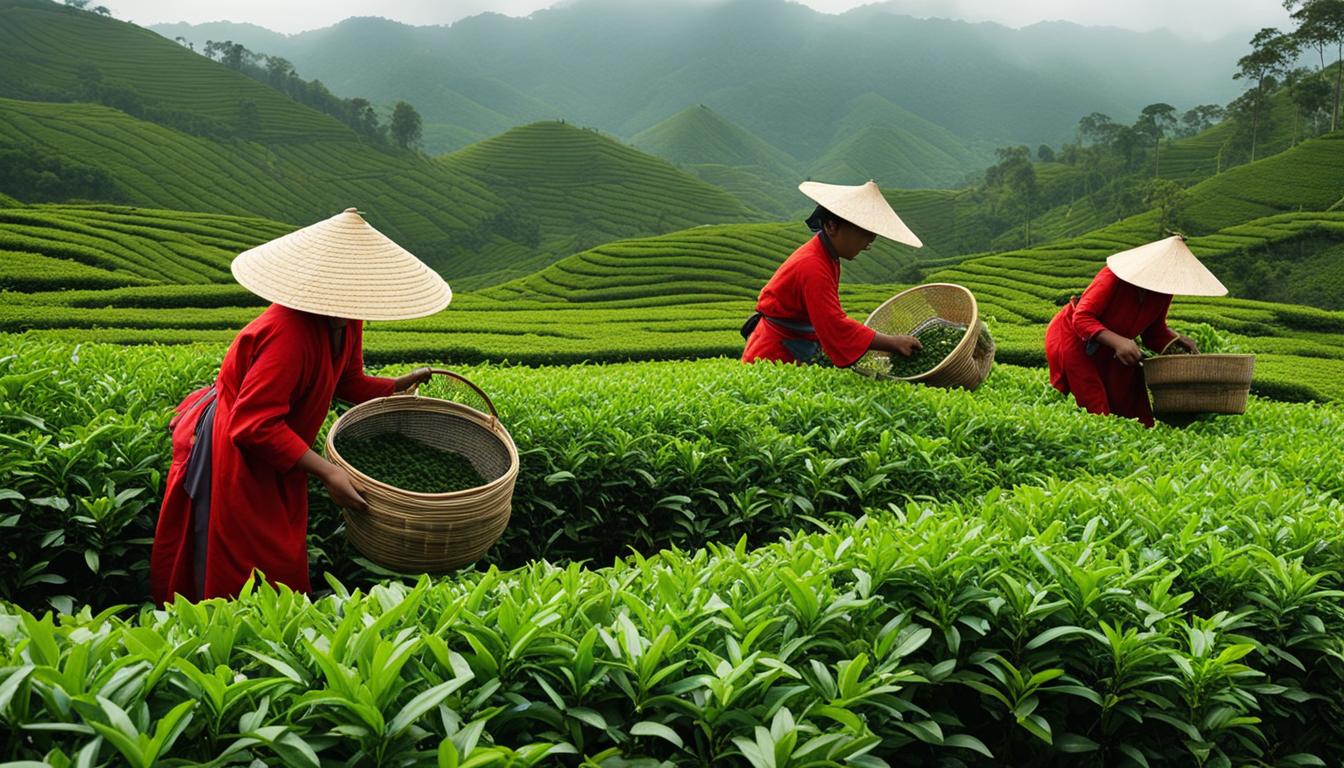Transitioning from manual to mechanical tea harvesting is a major decision for tea producers. The 2016 Annual Bulletin of Statistics highlights the wide disparities in average yields of tea per hectare around the world, with Turkey having the highest average yield due to almost 100 percent mechanical harvesting. Manual tea picking is under scrutiny as machines offer speed and cost savings. The cost of labor in countries like India is a challenge, leading to initiatives towards mechanization. However, manual labor is still important for quality leaf selection, especially by small farmers.
Key Takeaways:
- Transitioning from manual to mechanical tea harvesting is a major decision for tea producers.
- Mechanical tea harvesting offers speed and cost savings but may compromise quality.
- The cost of labor in countries like India is a challenge for manual tea picking.
- Manual labor is still important for quality leaf selection, especially for small farmers.
- Advancements in mechanical tea harvesting aim to improve efficiency and quality.
Benefits of Manual Tea Harvesting
Manual tea harvesting offers several benefits that contribute to the quality and cultural significance of tea production. The traditional practice of hand-picking tea leaves allows for selective harvesting, ensuring that only the best-quality leaves are selected. This meticulous process results in teas with enhanced flavor profiles and complexity. Moreover, manual tea harvesting preserves cultural traditions in tea-growing regions, where manual labor plays a significant role in the rural economy.
One of the key advantages of manual tea harvesting is the skill and expertise required by the workers. Manual harvesters possess the knowledge and experience to identify the optimal leaves for plucking, ensuring that only the freshest and most tender leaves are selected. This attention to detail contributes to the production of high-quality teas that are highly sought after by tea connoisseurs.
Additionally, small-scale tea farmers often rely on manual harvesting methods due to the size of their operations and the unavailability of mechanical equipment. These farmers, typically from remote and hilly regions, benefit from the flexibility and personalized care that manual tea harvesting provides. It allows them to carefully tend to their crops and maintain the quality and integrity of their teas.
Quote:
“Manual tea harvesting allows us to hand-pick the best leaves, resulting in teas that embody the rich traditions and flavors of our region. It’s a labor-intensive process, but it’s worth it for the exceptional quality we produce.”
Cultural Traditions in Manual Tea Harvesting
The practice of manual tea harvesting is deeply rooted in the cultural fabric of tea-growing regions. It serves as more than just an economic activity; it is a way of life and a source of pride for local communities. Manual tea harvesting provides employment and income opportunities for rural populations, often helping to sustain their traditional way of living.
In many tea-growing regions, such as Darjeeling in India or Uji in Japan, manual tea harvesting is a skill passed down through generations. Women are often actively involved in the harvest, nurturing and shaping the tea gardens with their expertise. This engagement of the local community in tea production strengthens the bond between the people and the land, fostering a deep sense of connection and cultural continuity.
Small-scale Manual Tea Harvesting Practices
Small-scale tea farmers play a significant role in the tea industry, particularly in regions where mechanization is limited. These farmers utilize manual tea harvesting practices due to the scale of their operations and their reliance on traditional methods. By hand-picking their tea leaves, they can carefully manage the quality of their harvests and produce teas that are distinctively unique.
Small-scale manual tea harvesting often involves a close-knit community of farmers working together to tend to their tea gardens. The cooperative nature of their operations fosters a sense of camaraderie and shared responsibility. It also allows them to uphold sustainable farming practices by minimizing the use of machinery and chemicals, resulting in teas that are not only delicious but also environmentally friendly.
Table: Comparison of Manual and Mechanical Tea Harvesting
| Factors | Manual Tea Harvesting | Mechanical Tea Harvesting |
|---|---|---|
| Labor Requirements | High labor requirements | Reduced labor requirements |
| Quality Control | Selective picking for enhanced quality | Potential for damage to leaves |
| Cost | Higher labor costs | Potential for reduced labor costs |
| Cultural Significance | Promotes cultural preservation | Minimal cultural significance |
Note: The table provides a general comparison between manual and mechanical tea harvesting practices. Actual outcomes may vary depending on specific circumstances and farming techniques.
Efficiency of Mechanical Tea Harvesting
Mechanical tea harvesting offers increased efficiency, especially in large tea estates. The use of machines significantly speeds up the harvesting process, resulting in higher production output and reduced labor costs. Ride-on harvesters, for example, can cover large areas quickly and efficiently, saving both time and resources.
However, it is important to consider the environmental impact of mechanical tea harvesting. Improper operation of machinery can cause soil compaction and damage to the tea bushes. This can lead to decreased yield and quality of the harvested leaves, impacting the overall sustainability of tea production.
Environmental Impact of Mechanical Tea Harvesting
Mechanical tea harvesting, while efficient, has its drawbacks when it comes to environmental sustainability. The use of machinery requires fuel and energy input, contributing to carbon emissions and environmental pollution. Additionally, the compacting of soil and damage to tea bushes can have long-term consequences for the health of the tea garden.
However, there are ongoing efforts to mitigate the environmental impact of mechanical tea harvesting. Companies are developing more sustainable and eco-friendly harvesting machines that minimize their carbon footprint. These advancements aim to strike a balance between efficiency and environmental responsibility.
Mechanical Tea Harvesting in Large Estates
Mechanical tea harvesting is particularly beneficial for large tea estates due to the scale of operations. With vast areas to cover, manual labor can be time-consuming and cost-intensive. The use of mechanical equipment allows for a faster and more streamlined harvesting process. This not only increases productivity but also reduces the reliance on a large labor force, which can be challenging to maintain in certain regions.
Quality Comparison between Manual and Mechanical Harvesting
When it comes to tea harvesting, there has always been a debate around the quality of manually picked tea versus mechanically harvested tea. Traditionalists argue that hand-picked tea offers superior quality due to the selective picking and gentle handling of the leaves. However, advancements in mechanical harvesting technology have led to significant improvements in the quality of mechanically harvested tea as well.
Manufacturers and plant engineers have developed machines that can mimic the manual picking process, ensuring less damage to the leaves. By carefully calibrating the harvesting equipment, mechanical harvesters can be adjusted to selectively pluck only the top-quality leaves, resulting in a tea that is comparable to hand-picked varieties. This eliminates concerns about compromised quality when choosing mechanical harvesting methods.
However, it is important to note that the skill and care taken during both manual and mechanical harvesting play a crucial role in the final quality of the tea. Even with advanced technology, human expertise is required to ensure optimal leaf selection and processing. Both manual and mechanical harvesting methods have their unique advantages, and the choice between the two ultimately depends on the specific goals and circumstances of the tea producer.

| Manual Harvesting | Mechanical Harvesting | |
|---|---|---|
| Quality | Selective picking ensures high-quality leaves | Advanced machines mimic manual picking, resulting in improved quality |
| Efficiency | Slower process, limited by human labor | Higher production output, reduced labor costs |
| Environmental Impact | Low carbon footprint, minimal use of machinery | Potential soil compaction and damage to tea bushes |
| Labor Costs | Higher due to manual labor requirements | Lower due to reduced labor needs |
Ultimately, the decision between manual and mechanical harvesting should be based on a careful evaluation of the specific needs and priorities of tea producers. While manual harvesting may offer benefits in terms of selective picking and cultural traditions, mechanized methods provide increased efficiency and cost savings. The ongoing advancements in technology and practices aim to improve both the quality and sustainability of tea production, ensuring that tea lovers can enjoy a wide range of high-quality options, regardless of the harvesting method employed.
Labor Costs in Manual Tea Harvesting
One of the major challenges faced by tea producers in manual tea harvesting is the cost of labor. In countries like India, labor costs account for a significant portion of production expenses. Rising wages, seasonal fluctuations in the availability of labor, and the difficulty of finding skilled workers create additional obstacles for tea farmers.
The cost of manual tea harvesting can significantly impact the overall profitability of tea production. As labor costs continue to rise, tea producers are faced with the challenge of finding ways to reduce expenses without compromising on quality. This has led to a growing interest in adopting mechanization as a means to minimize labor costs and improve efficiency.
By transitioning from manual to mechanical tea harvesting, tea producers can save on labor costs and increase productivity. Mechanical equipment, such as ride-on harvesters, can cover large areas quickly and efficiently, reducing the need for manual labor. Additionally, mechanization allows for a more consistent and standardized harvesting process, which can improve overall efficiency and quality.
However, it is important to note that the transition to mechanical tea harvesting may not be suitable for all tea producers. Small-scale farmers, in particular, may face challenges in adopting mechanization due to the high cost of equipment and the limited availability of resources. Furthermore, manual labor plays a significant role in the cultural traditions and practices of tea-growing regions, making it an important consideration for many tea producers.
Cultural Traditions and Worker Skills in Manual Tea Harvesting
Manual tea harvesting is more than just a method of gathering tea leaves; it is steeped in the rich cultural traditions of tea-growing regions. In many parts of the world, tea picking is not just a job, but a way of life that has been passed down through generations. It provides employment for rural communities and plays a significant role in preserving local customs and practices.
Worker skills are essential in the manual tea harvesting process. Selective picking is a vital aspect of achieving high-quality teas, and it requires expertise and experience. Skilled workers are trained to recognize the perfect timing and angle for plucking the tea leaves, ensuring that only the finest leaves are harvested. They are also adept at handling the delicate leaves, minimizing damage and preserving the flavor profile of the tea.

Environmental Impact of Mechanical Tea Harvesting
When it comes to the environmental impact of mechanical tea harvesting, there are several factors to consider. Firstly, the use of machinery can result in soil compaction, which can hinder the growth and health of tea bushes. Additionally, if not properly managed, mechanical harvesters can cause damage to the plants themselves, leading to lower yields and potentially affecting the long-term sustainability of tea estates.
Another aspect to consider is the fuel and energy input required for operating mechanical tea harvesters. This reliance on fossil fuels contributes to carbon emissions and contributes to environmental pollution. However, it’s important to note that advancements in technology are being made to address these concerns. Companies are developing more sustainable and eco-friendly harvesting machines, aiming to minimize their carbon footprint and reduce reliance on non-renewable energy sources.
In summary, while mechanical tea harvesting offers increased efficiency and cost savings, it is crucial to carefully manage and mitigate its impact on the environment. By adopting greener practices and technologies, tea producers can minimize soil compaction, damage to tea bushes, and reduce carbon emissions. Striking a balance between efficiency and sustainability is key to ensuring the long-term viability of the tea industry.
Conclusion
After exploring the world of tea harvesting, we can conclude that the choice between manual and mechanical methods depends on various factors. The decision of whether to go manual or mechanical ultimately rests on considerations such as labor availability, cost, and desired tea quality.
Manual tea harvesting offers unique benefits, such as the ability to selectively pick only the best-quality leaves. It also plays a crucial role in preserving cultural traditions and providing employment for rural communities. On the other hand, mechanical tea harvesting provides increased efficiency and cost savings, especially for large estates. The use of machinery speeds up the process, resulting in higher production output and reduced labor costs.
When it comes to tea quality, there is an ongoing debate between manual and mechanical harvesting. Hand-picked teas claim to have superior quality due to the gentle handling of the leaves. However, advancements in mechanical technology have led to improvements in quality as well. Manufacturers have developed machines that mimic the selective picking process, resulting in less damage to the leaves.
Ultimately, both manual and mechanical tea harvesting have their advantages and challenges. The decision should be based on the specific circumstances and goals of the tea producer. As technology continues to advance, we can expect further improvements in the quality and sustainability of both methods. So, whether you choose to go manual or mechanical, remember that the art of tea harvesting is a delicate balance between tradition and innovation.
FAQ
What are the benefits of manual tea harvesting?
Manual tea harvesting allows for selective picking to ensure only the best-quality leaves are harvested. It also helps preserve cultural traditions in tea-growing regions and requires specific skills, resulting in higher-quality teas.
How does mechanical tea harvesting increase efficiency?
Mechanical tea harvesting speeds up the process, allowing for higher production output and reduced labor costs. Machines like ride-on harvesters can cover large areas quickly and efficiently.
Is there a difference in quality between manual and mechanical tea harvesting?
Hand-picked teas claim to have superior quality due to selective picking and gentle handling of the tea leaves. However, advancements in mechanical harvesting technology have led to improvements in quality as machines can mimic the manual picking process.
What are the labor costs associated with manual tea harvesting?
Manual tea harvesting is labor-intensive and can be costly for tea producers, especially in countries with rising wages and seasonal fluctuations in the labor force.
How does manual tea harvesting preserve cultural traditions?
Manual tea harvesting is deeply rooted in the cultural traditions of many tea-growing regions. It provides employment for rural communities and plays a role in preserving local customs and practices.
What is the environmental impact of mechanical tea harvesting?
Mechanical tea harvesting can cause soil compaction and damage to tea bushes if not properly managed. It also requires fuel and energy input, contributing to carbon emissions and environmental pollution. However, advancements in technology aim to reduce the impact and develop more sustainable harvesting machines.
Which method is better, manual or mechanical tea harvesting?
The choice between manual and mechanical tea harvesting depends on various factors, including labor availability, cost considerations, and desired tea quality. Both methods have their advantages and challenges, and the decision ultimately depends on the specific circumstances and goals of the tea producer.





